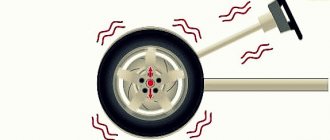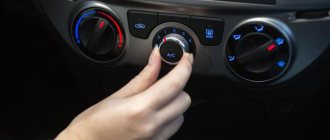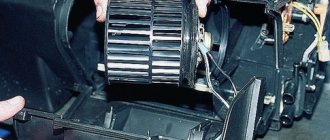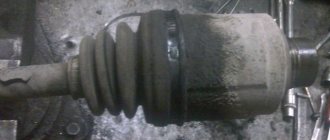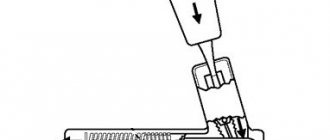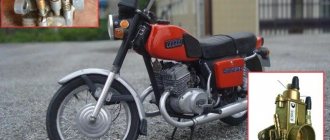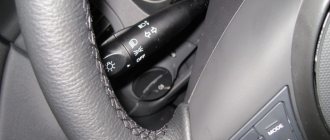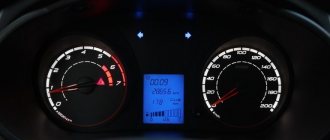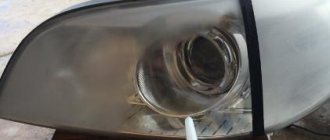Many car enthusiasts have encountered vibration, or, as it is also called, steering wheel knock. A slight vibration can be considered normal, but a knock that strongly resonates in the hands cannot be called normal. In fact, steering wheel vibration may indicate problems that are not directly related to the steering mechanism. As is the case with almost all automotive mechanisms, ignoring the problem can have serious consequences. Let's figure it out and at the same time study how problems can be prevented.
When the driver feels vibration in the steering wheel
Practice shows that almost all car owners are familiar with the problem of steering wheel wobble. However, there are several situations in which this same beating can be observed. And here are the situations we are talking about:
- Car braking;
- Sharp turns on bumpy roads;
- Measured movement at low speed;
- Movement at very high speeds - from 80 kilometers per hour and above.
As you can see, completely different situations are listed. They need to be disassembled separately, which is what we will do now. Let us immediately note that such a problem cannot , and it is usually solved quite quickly . Although diagnostics and purchase of spare parts or tires can cost a pretty penny, the expenses are justified by the safety and comfort of further driving.
Vibrations at high speeds
At speeds above 80 kilometers per hour, the steering wheel may shake noticeably. As a rule, the beats become especially strong from 100 kilometers per hour. And the point is this: when the mass of the wheels at different points is not aligned (the wheels are not balanced), the so-called centrifugal force that pulls one of the wheels along with it. The driver feels this when holding the steering wheel - it begins to vibrate strongly. But that's not all! As practice has shown, the action of centrifugal force is, as it were, reinforced by a number of other factors. Among them:
- Deformation of wheel rims . Typically, steering wheel wobble is observed due to mechanical damage to discs that have been in use for a long time. In rare cases, discs may already have a defect from the factory - if you notice this initially after purchase, be sure to return the discs to the seller;
- Tire surface deformation . Namely, the side surface. This deformity is also called a hernia. Pay attention to each of the wheels - if at least one tire has a clearly visible bulge or a mechanical defect in general, it needs to be replaced;
- Wheel bearing failure . If the wheel bearing fails, the wheel will not rotate smoothly. The driver will be able to feel this through the steering wheel;
- Weak tire inflation . Usually, poorly inflated wheels do not make themselves visible through the steering wheel - the whole car begins to vibrate - but it is simply impossible not to mention such a problem.
Spare parts for Chevrolet aveo
Motor oil
AVEO sedan (T250) (05.05 — )
Spare parts for Chevrolet lacetti
Motor oil LACETTI sedan (J200) (03.03 — )
Try to pick up speed and make sure that the steering wheel shakes when moving quickly. Then stop and carefully inspect the tires. Next stage: checking the wheel bearing, balancing the wheels. Please note that defective tires can cause steering vibration even if the wheels are perfectly balanced. Also, when visiting a workshop, we recommend that you draw the specialist’s attention to the issue of correct wheel installation .
In some cases, the installed hubs simply do not fit the rims. The unfortunate craftsmen could also have incorrectly tightened the wheel bolts or nuts with conical bases.
Results
We have compiled a list of possible symptoms that you may observe in your own car. Malfunctions of these systems not only cause unpleasant shaking of the car, but also entail certain risks associated with a decrease in traffic safety. If any changes to your vehicle's handling cause you concern, have it checked to avoid trouble and major, costly repairs.
Spare parts for Opel Omega
Central steering rod
OMEGA B sedan (25, 26, 27) (03.94 - 07.03)
Steering wheel vibration at low speed
Not the most common problem, because, according to statistics, drivers more often complain about steering wheel vibrations at high speeds. However, from these statistics we can glean something very interesting: car owners are more likely to experience problems of this nature in the winter . If the steering wheel starts to shake at low speed, you should think about the following:
- Have the wheel rims collected a large amount of dirt? It may not sound very plausible, but dirty rims can cause steering wheel vibration. The same applies to snow and ice stuck to the discs;
- Are the wheel bolts properly tightened? The classic cause of steering wheel vibration;
- What condition are the ball joints in? As a rule, heavily worn ball joints cause the steering wheel to wobble when accelerating;
- Is there any deformation of the discs? Vibration is also a very common cause. At first, the deformable discs only twitch slightly, but after a while they remind you of themselves through the steering wheel.
As you can see, the reasons are purely technical. It is enough to inspect the rims and diagnose the ball joints. We also advise you to pay attention to the engine mount. It sometimes happens that steering wheel vibrations are observed on cars with a badly worn air conditioning fan, since it constantly operates at maximum speed.
Damage from vibration
ATTENTION! A completely simple way to reduce fuel consumption has been found! Don't believe me? An auto mechanic with 15 years of experience also didn’t believe it until he tried it. And now he saves 35,000 rubles a year on gasoline! Read more"
At speed, vibration of the car body is not only discomfort for the driver and passengers, it is also harmful to the car as a whole. After some time, cracks appear in the car body due to vibration. In addition, bolts and nuts begin to unscrew spontaneously, which leads to dangerous consequences in the future. Thus, there is a risk of emergency situations. In addition, vibrations are harmful to human health, cause vasoconstriction, impair blood circulation, lead to the deposition of salts in joints, reducing mobility, with prolonged exposure.
Steering wobbles when cornering or on bumpy roads
Everything gets more interesting here. If steering wheel beating is observed at high or low speeds, you need to check the rims, fasteners, and also balance the wheels. But if the problem occurs when turning or while driving on a poor-quality road, you need to check several elements of the chassis and steering mechanism:
- Tie rod ends . If driving on bumpy roads gives a lot of feedback to the steering wheel, you need to check the tips. In a good way, this should be done in the inspection hole and with an assistant who will turn the steering wheel while you monitor the operation of the tips. In the tips, the liners and anthers wear out first;
- Steering rack . If on bad roads the driver feels vibration that turns into clearly noticeable shocks, it is worth checking the steering rack fastening. Also check the bushing - it wears out relatively quickly;
- CV joint Everything is simple here: if the driver hears a “crunch” in the wheel area, you need to change the corresponding hinge;
- Shock absorbers . The purpose of shock absorbers is to soften shocks and increase driving safety and comfort. Sometimes drivers get used to hard shock absorbers and even begin to drive more carefully, but if the steering wheel begins to vibrate, the shock absorbers should be checked and, if necessary, replaced;
- Silent blocks . The simplest diagnosis of silent blocks on a raised car includes a visual inspection, studying the behavior of the levers when swinging, as well as listening to detect knocking noises. Experts advise immediately changing silent blocks that do not inspire confidence;
- Steering gear bearings . They often cause steering wheel vibration. If the steering gear knocks when entering a turn, and the steering wheel itself begins to vibrate noticeably, it is worth checking the thrust bearings.
As you can see, you can diagnose the suspension and steering mechanism yourself. An inspection hole or a jack, as well as the help of a second person, will be very useful here. However, we recommend contacting a service station - specialists will carry out diagnostics much faster and with better quality. As for the choice of spare parts for repairs, here it is worth giving preference either to the originals or to those manufacturers who supply their goods to automakers.
Vibrations while driving
As you engage the gear and drive off, many components begin to rotate. If vibrations occur while driving on the road, the first thing to check is the tires, although they may not be the problem. Here, by the way, the components mentioned in the previous paragraph can come into play.
Wheel imbalance
Wheels are the largest rotating components of any car. While the vehicle is moving, the tires are constantly in contact with the road surface. This means they get caught in potholes and cracks, as well as bumping into rocks, debris and other debris found on the road.
The new tires are perfectly balanced and rotate smoothly without any sign of vibration. But after some time, they become unbalanced. This leads to vibrations that are transmitted to the steering wheel or to the car body.
Vibration from unbalanced wheels is usually felt in the speed range of 80-110 km/h.
Solution: Contact a mechanic or visit your nearest tire shop to have the problem resolved. This procedure will not take much time and will not cost a lot of money, provided that the tires are not damaged.
See also:
The smell of gasoline in the car interior: causes and elimination
Steering wheel vibration when braking
Often the causes of beating need to be looked for in the brake system. Namely, in brake discs and pads. As all car enthusiasts probably know, brake discs get very hot during operation. The process of thermal expansion of metals, which is simply called deformation due to overheating , causes steering wheel vibration. When heated and then rapidly cooled, brake discs become wavy, and the drum simply becomes uneven. We also cannot fail to mention the problem of brake disc contamination.
Pay attention to the brake pads. After grinding in, their surface does not always become perfectly smooth. After pressing the brake pedal, due to the irregular shape of the brake pads, the brakes begin to vibrate, and this same vibration is transmitted to the steering wheel. It is also worth examining the caliper - it may press the pads against the disc unevenly, which causes vibrations. Brake calipers need to be cleaned of rust and lubricated.
Additional problems
While the throttle cable as a whole does a meaningful job of isolating large vibrations, minor high-frequency vibrations can still make their way through the taut cable and into the pedal. Your engine's vibration damper and flywheel will absorb most of this vibration, but these components cannot handle problems they are not designed to handle.
Bad alternator bearings, power steering pump and AC compressor can cause vibrations, but also tend to cause some noise when running. Loose accessory brackets allow minor parts to vibrate back and forth, and a severely bent or damaged cooling fan blade vibrates and vibrates at a certain speed.
Vibrations when parked and idling
Sometimes car owners complain about steering wheel vibration when idling and when trying to move away. The vibration itself can be quite strong. The problem makes itself felt especially often in used cars that have not previously been subjected to frequent repairs and replacement of individual components. Vibration at idle can be caused by any of the following:
- Wear of power unit cushions . In this case, the pillows need to be changed and, just in case, the engine itself must be checked - if it begins to vibrate after a major overhaul, a check is mandatory;
- Worn steering rack . To be precise, wear of either the entire rack drive shaft or the splined part of the shaft. The vibration of the steering wheel with such a rack will increase as the speed increases.
Only checking and replacing worn parts will help here. Remember that the rubber-metal parts adjacent to the engine do not have the longest service life and must be changed regularly. On average, their resource is 100-120 thousand kilometers. In practice, this mileage can be either significantly greater or slightly less. The resource of analogue spare parts is significantly less.
Worn or faulty suspension or steering components
Excessively worn suspension components can affect how your car handles the road. This is because if any component (ball joint, tie rod, wheel bearing, etc.) has play, it will result in virtually the same imbalance in rotation as if the same wheels were unbalanced . But it can also cause other problems other than wheel balancing and excessive wear.
However, it should be borne in mind that play in the suspension components cannot directly affect and cause vehicle vibration or steering wheel wobble - in this case, the loose suspension part serves only as a catalyst, and the symptoms for this reason depend precisely on the main problem.
What are the consequences of ignoring the problem?
If you regularly hit the steering wheel while driving and you are even used to it, you should not think that the problem will not have consequences. Experienced car enthusiasts probably know that even the most wear-resistant mechanisms cannot tolerate frequent and strong vibration. It can damage almost any mechanism. It also does not have a positive effect on the driver. Please note that steering wheel vibration may increase over time. For example:
- For some reason, the steering wheel began to shake slightly. The problem is ignored;
- Tires wear out more. The beating becomes stronger;
- Bearings, suspension components, and individual elements of the steering mechanism wear out greatly. Driving a vehicle becomes much more difficult.
Experts are confident that the main problem with vibrations is the wheels, and in some cases, the brakes. The suspension of a car with a constantly vibrating steering wheel simply becomes weaker over time and its individual element may fail much earlier than expected.
The danger here is that the driver of a problematic car becomes less attentive and more irritable, which, coupled with the technical shortcomings of the vehicle, can cause an accident.
Other clutch faults
The vibration of the clutch pedal when pressed affects the behavior of the vehicle as a whole, which is difficult to ignore.
1. Incomplete inclusion.
The cause of this problem is the disc disconnecting from the flywheel. This manifests itself in the abrupt start of the car’s movement, jolts even when changing gears smoothly.
Vibration of the pedal when pressed occurs as a result of the following:
- Lack of additional free space between the bottom of the pedal and the floor . The distance varies for different cars; more detailed information on this information can be found in the vehicle instructions.
- The mechanism release drive is poorly adjusted . The problem is solved by correctly choosing the ratio of the two adjusting nuts. If the car is equipped with a hydraulic drive, the stroke of the cylinder rod needs to be adjusted, and then the stroke of the mechanism fork needs to be adjusted.
- Curvature of driven disks . When the end runout exceeds 0.5 mm, the lining is bent and pressed against the flywheel.
- Wedge of the driven disk hub, which occurs as a result of long-term vehicle inactivity . The malfunction can be solved by cleaning and lubricating the hub. If the problem cannot be resolved, it is necessary to replace the disk or the input shaft itself.
2. Clutch slipping.
Pressing the gas pedal is accompanied by a howling sound from the car, driving uphill is difficult, and picking up speed is slow. Another sign of a malfunction is a burning smell in the cabin.
This clutch pedal malfunction can be caused by:
- Lack or excess of free space between the bottom of the pedal and the floor.
- Contact with lubricant on the friction lining . This malfunction is typical for older cars, in which oil leakage is caused by leaky connections and worn out seals. The problem is solved by identifying the location of the leak and wiping the disk.
- Worn friction lining . There are two ways to solve the problem: replacing the lining or disc assembly - the second option is more preferable.
- Drive failure . You can diagnose the problem by placing the car in an inspection hole. Pressing the clutch pedal will allow you to see the cylinder pushing into the fork.
- Clogged compensation hole of the hydraulic clutch cylinder . To fix the problem, simply remove the cylinder and flush the hole.
3. It makes noise if you depress the clutch pedal.
Noises and vibrations occur when you press the pedal of the mechanism; after the pedal is released, the extraneous sounds disappear. Malfunctions can be judged by the nature of the noise, which can be either rustling or grinding.
The causes of noise and vibration of the clutch pedal when pressed can be:
- Worn release bearing caused by lack of lubrication or clogging of the race . The resource of the part is limited due to moisture ingress into it. Since the bearing is a non-separable element, to eliminate the malfunction it is necessary to replace it with a new one.
- Breakage and wear of the springs of the driven disk, the “basket” plate of the unit . The problem is solved by replacing unsuitable parts.
- Front bearing wear . To eliminate the malfunction, a part replacement is required, which is impossible without partially disassembling the gearbox.
We recommend
“Car clutch malfunctions: rating of breakdowns and causes of their occurrence” More details
4. The pedal has sunk to the floor or squeaks are observed.
A failed pedal can only be removed by force. The malfunction may be caused by a jammed drive or worn release bearing. If the car has not been driven for a long time, there may be problems with the cylinder rod and pedal spring. If there is no vibration of the clutch pedal when pressed, but squeaks are heard when pressed in, it is necessary to inspect the axle bushing that secures this lever. The problem is solved by lubrication.
5. Disengage the clutch if you squeeze it sharply.
Owners of cars with a hydraulic clutch may experience failure of the mechanism when smoothly squeezing and releasing the pedal.
The causes of the malfunction may include:
- insufficient amount of fluid in the mechanism;
- leaky connection of clutch tubes and hoses;
- wear, damage to the cuffs of the master cylinder.
6. Jerks and jerks during operation of the unit.
If vibration of the clutch pedal when pressed is not caused by drive problems, then it is necessary to remove and inspect the basket with the disc. The reason may be wear on the linings or loosening of the rivets used to secure them. You can deal with the problem by tapping the rivets with a hammer.
7. The clutch is easily released.
If air gets in, the mechanism may fail. The low pressure created by the fluid will not allow the elements of the mechanism to move at normal speed, so when you press the pedal, changing gears will be difficult. To solve the problem, you need to remove air from the assembly.
If you have doubts about the serviceability of the mechanism, do the following: first, warm up the car, then activate the parking brake by pressing the gas pedal, increase the speed to 1,500–1,800, then depress the clutch to the limit, shift the gearbox to first gear and smoothly release the pedal .
The fact that the mechanism is faulty will be indicated by an engine that does not stall or stalls after a certain period of time.
Conclusion
Engine vibration can indicate many problems in various parts of the car. This includes the brake, the chassis, the steering mechanism itself, and sometimes even engine fasteners. Since vibrations only indicate something more, a car enthusiast should never ignore the problem - he needs to plan a trip to a service station and carry out repair work as early as possible. The car owner can do only a few things on his own: check the brakes and wheels, lubricate the brake mechanisms, replace the rod ends or tighten the steering rack, and also check the condition of the boots and silent blocks.
